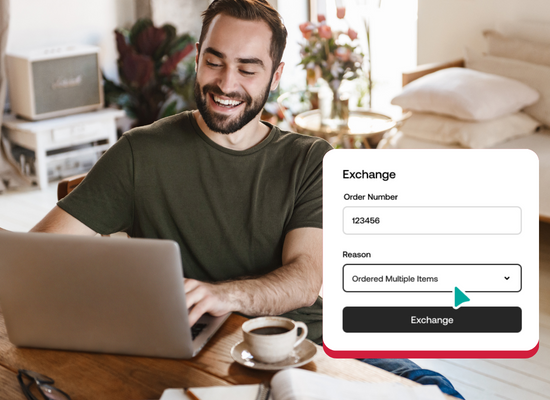What is an RMA and What Does it Mean for Shopify or BigCommerce Merchants?

Return Merchandise Authorization (RMA) is a process and system implemented by Shopify or BigCommerce merchants to manage and facilitate returns and exchanges. It can also be referred to as a Return Authorization (RA) or Return Goods Authorization (RGA). An RMA is an official agreement between a store and its customers that allows the return or exchange of products.
RMAs are a systematic approach to managing product returns in the ecommerce industry. An RMA serves as a unique identifier for tracking and managing the return process efficiently. It allows Shopify and BigCommerce merchants to maintain visibility and control over the return process, ensuring that customers’ needs are met promptly and effectively.
To start, a customer first needs to request an RMA, which is then reviewed and approved by the merchant. A Return Merchandise Authorization (RMA) number is required when exchanging or replacing an item. It may also be issued if a customer is not satisfied with their purchase.
The RMA serves as a reference that allows for tracking and accountability throughout the return or exchange process. It helps customers monitor the progress and status of their return or exchange. RMAs are important for customer satisfaction. They help merchants provide the service their customers deserve.
An RMA system or RMA software ensures that customers and merchants are on the same page regarding return policies. They also help prevent fraudulent returns. In short, the RMA meaning includes a formal procedure that assists merchants in tracking returned items and authorizing and managing returns across the supply chain.
What is an RMA Number?
RMA numbers, or Return Merchandise Authorization numbers, serve as essential tools in the realm of product returns. Unique identifiers are assigned to each return. This allows merchants to track the journey of the returned products to their warehouses efficiently.
Once the returned product reaches the facility, the inventory management software is updated accordingly. Return Authorization Numbers hold even greater significance for stores that offer servicing and repairs for warranty-returned products.
A customer needs to obtain an RMA number from a merchant to return a product. This number is used to track the return. Additionally, the customer needs to provide proof of purchase, such as a receipt, in order to be eligible for an RMA.
When a customer wishes to return a product, obtaining an RMA number from the merchant is a prerequisite. This number acts as a reference point for the return process. It lets both the customer and merchant track the progress of a return. It provides transparency and accountability, ensuring that the returned item is properly documented and accounted for.
RMAs for Warranty Returns
The significance of RMA numbers becomes even more pronounced for merchants that offer servicing and repairs for warranty-returned items. Unique identifiers streamline the return process. They also play a vital role in managing inventory and updating inventory management software.
RMA numbers allow for accurate updates to the inventory management software, ensuring real-time visibility of returned items and their status. Shopify and BigCommerce merchants can assign RMA numbers to warranty-returned items to track the status and location of those products. This ensures efficient handling and accurate inventory records.
This seamless integration of RMA numbers into the inventory management system enables store owners to provide prompt service, maintain optimal stock levels, and uphold customer satisfaction.
What Does the RMA Process Look Like?
The purpose of an RMA is to streamline the return process and provide a standardized framework for handling customer returns. By implementing an RMA system, ecommerce brands can enhance customer satisfaction, build trust, and improve overall operational efficiency.
There are 6 key components to the RMA process. Ecommerce merchants must optimize each step to create a streamlined returns process. This will increase customer satisfaction and loyalty, as well as reduce costs and return rates. Success is achievable with effective optimization.
Step 1: Customer Initiates the Return Request

The RMA process begins when a customer initiates a return request. During this step, the customer provides the relevant information required for processing the return effectively. This typically includes the reason for the return, the order number associated with the purchase, and detailed information about the specific product being returned.
Return reasons provide merchants with feedback directly from the customers themselves. Returns data collected through RMAs can help identify patterns. These patterns identify any potential issues in product quality, customer service, or other areas of concern. The returns data, along with the reasons given for the return, can help us pinpoint the root cause of these issues.
Order numbers are unique identifiers. They allow ecommerce merchants to trace the original purchase. This ensures accurate processing and avoids confusion with other transactions.
Gathering detailed product information from customers provides merchants with data. This data includes information about various product variations and how they compare to each other and other products.
Customers initiate the return request by sharing essential details. This sets the wheels in motion for a smooth RMA process. Effective communication is facilitated, ensuring a satisfactory return experience.
Step 2: Return Authorization
After reviewing the return request, the ecommerce merchant evaluates if the product is eligible for a return. This evaluation may take into account the item’s condition, compliance with return policies, warranty period, and the reason for return.
As an ecommerce merchant, you’ll have your own conditions for returns, which should be outlined in your return policy. These conditions will determine if a product is eligible for a return. These policies may specify timeframes for returns, requirements for original packaging and labels, and guidelines for product condition.
Once a return is initiated by the customer, customer service representatives can easily qualify whether a return will be accepted based on the information provided. Customer service representatives can use an RMA automation process to keep the customer and warehouse informed about the status of the return. This eliminates the need for emails or phone calls.
After the review process is complete, and it is determined that the return request meets the necessary criteria, customers are issued an RMA number. This RMA number serves as a return authorization and a unique identifier for the return. It plays a vital role in tracking the return throughout the entire process, from initiation to resolution.
Step 3: Packaging and Labeling of the RMA

After the customer has been given a Return Authorization Number, it’s time for the customer to package the product safely to return it to the merchant. Customers should include a copy of the RMA number with the product when returning it to the merchant. This allows them to verify that the product is in the same condition as when they received it.
It is essential for ecommerce merchants to make instructions on packing products clear and concise. This will make it easier for customers to comprehend the process. This may involve using the original packaging or specific shipping materials to ensure the item’s safe transportation.
Delivery without proper protection can damage the product. This can affect its eligibility for a return when it reaches the warehouse, which will create a very negative return experience for customers. Seeing as this isn’t good for building brand loyalty or customer retention, providing customers with what they need to get returned products delivered safely is the best practice.
Step 4: Shipping and Tracking the Return
Customers are responsible for following the instructions provided by the merchant to properly ship returned products back to the warehouse. Offering customers easy return shipping options helps to prevent the returns experience from becoming frustrating. This can encourage customers to continue shopping with you.
Convenient shipping options can include offering customers prepaid shipping labels or partnering with shipping carriers for more convenient delivery. Ecommerce merchants who use returns management software have more control over the shipping options they can provide to customers.
With returns management software, merchants can automate prepaid or printerless shipping labels, enable specific shipping rules based on return type, and track and monitor shipments as they make their way back to the warehouse.
A shipment tracking number is generated once the package is dropped off or collected by a shipping carrier. The tracking number is then sent to the customer. This is usually automated by the shipment carrier (FedEx or UPS) and information is sent to the returns management software. Tracking the return shipment is essential to monitor its progress and ensure its safe arrival.
Step 5: RMA Inspection & Processing

Upon receiving the returned item, the warehouse and operations team conduct a thorough inspection to verify its condition. This step involves checking for any damage or signs of use that may affect the eligibility for a refund or exchange.
After the inspection, the warehouse team communicates the disposition of the product to the customer service team. If the item meets the required product return criteria, the customer service team proceeds with processing the return or exchange. This may involve issuing a refund, offering store credit, or shipping a replacement product in place of a defective product.
Returns management software and warehouse inventory management tools are often used. They help to track the returned product. The product can be put back into stock, liquidated, or marked as damaged.
The RMA Software simplifies the process for warehouse and operations teams. They can quickly inform customer service teams about the status of returned products. This reduces the time it takes to complete the process.
Step 6: RMA Resolution and Communication with the Customer
Once the inspection is complete, the store communicates the resolution of the return to the customer. This can include issuing a refund, providing store credit, exchanging the item, or offering a repair.
You can streamline this process and make it more efficient by implementing an automated email system. This system can be triggered by the authorization status within the RMA software. Automating messaging can be beneficial for the returns process. It reduces the risk of customers and returns being missed due to human error, even when resources are limited.
By relying on RMA automation systems, customer service teams no longer have to worry about the burden of manual communication. This allows them to dedicate their time and effort to building stronger relationships with customers through more impactful means.
Implementing an automated returns management system allows Shopify and BIgCommerce merchants to:
- Give customers real-time updates and notifications
- Create a positive returns experience for customers
- Ensure smooth and efficient handling of each return
- Meet customers’ needs in a timely manner
An automated returns management system takes care of customer notifications, freeing up customer service teams. This allows them to focus on building strong relationships with customers that will have a more significant impact.
Importance of RMAs for Your Shopify or BigCommerce Store
RMAs play a vital role in the ecommerce industry for several reasons. They provide a structured and standardized approach to handling returns, which ensures consistency and efficiency. This helps merchants save time and resources by following established procedures rather than dealing with ad-hoc return processes that require extensive amounts of manual labor.
RMAs also contribute to customer satisfaction and trust. By offering a seamless return experience, ecommerce merchants can build positive relationships with their customers and enhance their overall shopping experience. This, in turn, leads to customer loyalty and increased customer lifetime value.
Furthermore, RMAs enable merchants to gather valuable data and insights. Tracking and analyzing returns reasons allows merchants to take proactive measures to improve product quality, packaging, or customer service. This data-driven approach helps optimize business operations and reduce return rates over time.
Want to make your retail business better with RMAs? Book a demo with one of our experts to learn more about ecommerce returns management!
Ready to simplify your returns management?
Schedule a free ecommerce returns audit today!







